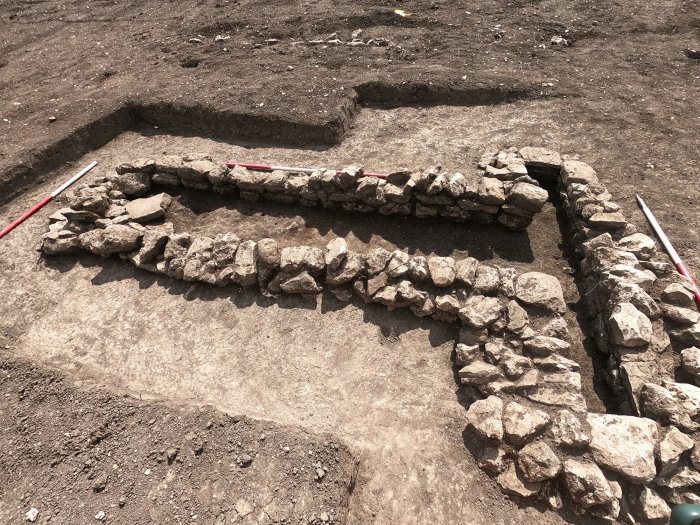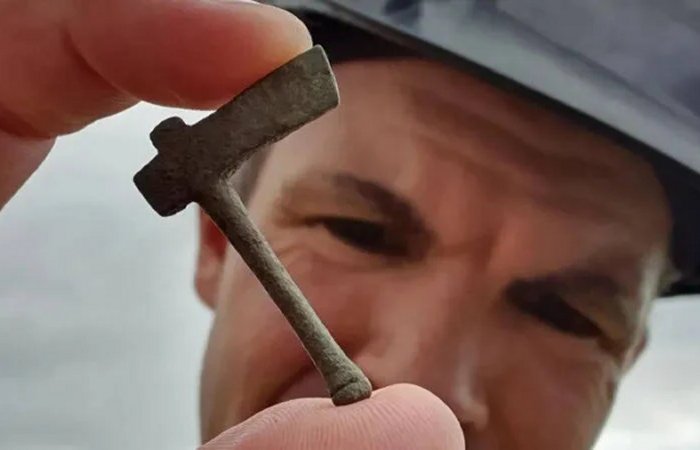Roman Villa Full Of Miniature Votive Axes, Curse Tablets And Strange Artifacts Discovered In Oxfordshire

Jan Bartek – AncientPages.com – During an excavation in Oxfordshire, England, archaeologists discovered the remains of a significant Roman villa complex. The site is situated in the village of Grove, approximately 60 miles west of London.
The villa is a great example of Roman architectural ingenuity. It consists of two massive structures and ornate designs.
A large Roman villa was uncovered in Oxfordshire. Credit: Red River Archaeology Group
The complex was adorned with intricate painted plaster and mosaics and housed a collection of small, tightly coiled lead scrolls. The Red River Archaeology Group (RRAG), the organization responsible for coordinating the excavation, announced in a press release that these elements suggest that the site may have been used for rituals or pilgrimages.
Francesca Giarelli, the Red River Archaeology Group project officer and the site director, told CNN that the villa likely had multiple levels. The Roman villa complex, spanning an impressive 1,000 square meters (or 10,800 square feet) on its ground floor alone, was likely a prominent landmark visible from miles away.
“The sheer size of the buildings that still survive and the richness of goods recovered suggest this was a dominant feature in the locality if not the wider landscape,” says Louis Stafford, a senior project manager at RRAG, in the statement.
What is particularly fascinating are the numerous artifacts discovered at the site. These findings provide valuable insights into the daily life in Roman Britain spanning from the first to fifth centuries C.E.
The horsehead buckle was dated to AD 350-450. Credit: Red River Archaeology Group
Archaeologists suggest that the unearthed miniature axes and scrolls may have been used in rituals. The tightly rolled scrolls resembled Roman curse tablets.
Defixiones, known as curse tablets, were much appreciated among Romans. The tablets were sold and bought by those who wished to cast malevolent spells on individuals or objects. “Ancient Romans believed in the power of spells and thought these magical curse tablets would help them destroy their enemies.” 1
These lead scrolls resemble Roman “curse tablets,” used to write messages to higher powers. Credit: Red River Archaeology Group
The miniature votive axes found at the site are similar to a collection of miniature weapons once found in the village of Uley, thought to have been offered to gods like Mercury.
The archaeology team also uncovered many artifacts, such as brooches, rings, coins, tableware, and a horse-decorated belt buckle. According to the statement, the belt buckle, believed to be from the period between 350 and 450 C.E., might have been owned by an individual of high Roman society. These findings indicate that the region was inhabited by Romans until around the fourth or fifth century C.E.
“The site is far more complex than a regular rural site and clearly was an important center of activities for a long time, from the Bronze Age to the later Roman period,” says Giarelli in the statement.
Miniature votive axes were found at the site. Credit: Red River Archaeology Group
As reported by CNN, “excavating the site, described as “remarkable” in a press statement, began before the housing developers Barratt and David Wilson Homes started their building work and after two evaluation trenches had been dug.
The trenches revealed a “high potential for archaeological presence,” Giarelli said, prompting an archaeological investigation, which began two months before the building work and is still ongoing.”
See also: More Archaeology News
Information regarding the lives of the villa’s inhabitants continues to be enigmatic. The researchers are yet uncertain about the final resting place of these individuals, although they hypothesize that a burial site may exist within the complex. Additionally, several intriguing artifacts unearthed during the excavation offer insights into their religious customs and belief
Archaeologists say that the site continues to present intriguing mysteries that are yet to be uncovered through ongoing excavations.
Written by Jan Bartek – AncientPages.com Staff Writer
Expand for references








